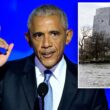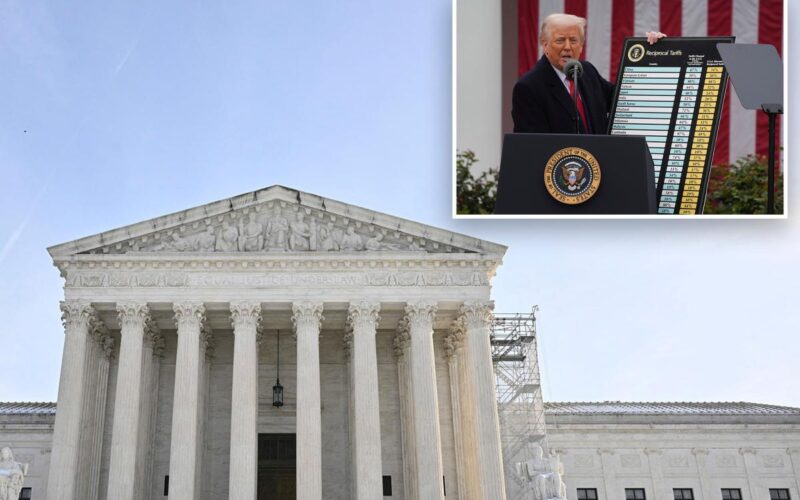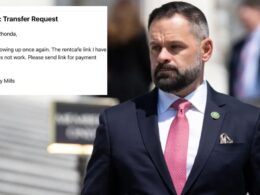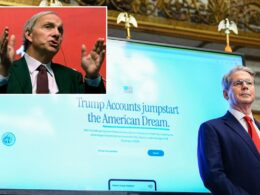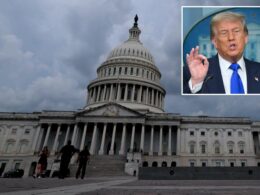WASHINGTON — President Trump’s tariff regime is facing its greatest test yet as the Supreme Court on Wednesday hears arguments on a pair of challenges against his use of emergency power to slap duties on countries around the world.
While Trump has enjoyed a remarkably successful track record so far before the high court during his second term, particularly on the shadow docket, many experts say there is widespread uncertainty over how the Supreme Court will rule on the momentous tariff case.
“It’s very uncertain given the makeup of the court,” Gregory Shaffer, a Georgetown Law professor who co-wrote an amicus briefing backing the lower court rulings against Trump, told The Post.
“It could be 50-50,” he added. “There are some justices, such as Justice [Neil] Gorsuch, who have earlier expressed concerns about Congress delegating its powers to the president.”
What tariffs could be impacted?
Since February, Trump has signed a raft of executive orders slapping tariffs on various countries.
At issue is Trump’s use of the International Emergency Economic Powers Act (IEEPA), which has been used to impose two key types of tariffs: “trafficking” duties aimed at countries for fentanyl flowing into the US, and “worldwide” or “reciprocal” tariffs imposing blanket levies due to concerns about the trade deficit.
That’s the bulk of Trump’s tariff regime.
IEEPA, which was passed in 1977, gives the president emergency powers to “investigate, block during the pendency of an investigation, regulate, direct and compel, nullify, void, prevent or prohibit…importation or exportation” of international commerce.
Crucially, IEEPA makes no mention of the word “tariff,” and no president has ever wielded the law the way Trump has to impose sweeping worldwide tariffs in the nearly 50 years it’s been on the books.
That is one of the key reasons why petitioners argue Trump can’t use IEEPA for his tariff blitz, and they hope that will appeal to the conservative majority’s originalist philosophy, which focuses on text and its intended meaning.
While no president has ever used IEEPA to impose tariffs, notably former President Richard Nixon used the precursor law, the Trading with the Enemy Act of 1917, to implement a 10% duty on imports into the US.
What are the legal principles at play?
The Supreme Court will hear a consolidated case based on challenges — one from a family-owned firms that make toys and a second from a wine importer and seller of women’s cycling apparel — that are both arguing IEEPA doesn’t give the president power to impose tariffs.
The lower courts have ruled against the president.
“Congress doesn’t need to use the word ‘tariff’ to delegate tariff power,” Chad Squitieri, a professor at Catholic University’s Columbus School of Law, who backs Trump’s perspective, countered. “The ordinary meaning of the phrase ‘regulate … importation’ includes tariff power.”
“Like how the ordinary meaning of a hypothetical statute mentioning ‘professional sports’ would be read to cover ‘baseball,’ the ordinary meaning of the phrase ‘regulate … importation’ is best read to include the power to impose tariffs.”
In many instances, the Supreme Court has shown deference to the presidency for national security issues, which could benefit Trump.
“I think they [the originalists] nod off in different directions on that,” Paul Stephan, a law professor at the University of Virginia School of Law, told The Post.
“That claim that runs through many of the briefs, particularly those supporting the government,” Stephan, who also filed an amicus brief against Trump’s tariff actions, believes the Supreme Court may rule against the president, added. “I’m not sure that it gets you over the goal line.”
Another key legal principle that could come up during oral arguments is Article I of the Constitution, which bestows Congress with the power to “lay and collect Taxes, Duties, Imposts and Excises.”
“The Roberts Court has held that where a statute is ambiguous and is subject to more than one reading, the court will apply the reading which will not raise a fundamental constitutional question,” Shaffer explained.
“If it applies that doctrine, the constitutional avoidance doctrine, then it will decide that ‘regulate’ doesn’t include setting tariffs.”
What recourse will Trump have if he loses the tariff case?
While it depends on how the Supreme Court rules, Trump does have a few other tools in his arsenal to bring back some of those tariffs besides IEEPA.
Senior White House trade adviser Peter Navarro has argued that the president could also turn to other authorities, such as Section 301 of the Trade Act of 1974, to impose those tariffs.
“They’re narrower,” Shaffer said of Trump’s other options. “Those other statutes don’t permit him to adjust tariffs worldwide across all tariff lines. That’s the reason why he has chosen IEEPA.”
“Those other statutes result in delay; they have time limits, they’ve got to be renewed.”
Trump is already using some of those tariff powers to impose some of his more specific duties on raw materials like steel and aluminum.
Fears mount that Trump will have to refund tariff revenue
If the high court goes against him, Trump’s team has raised concerns that the federal government may have to refund some of the tariff revenue, which it argues would be chaotic and cumbersome.
“We would have to give a refund on about half the tariffs, which would be terrible for the Treasury,” Treasury Secretary Scott Bessent warned on NBC’s “Meet the Press” last month.
“If the court says it, we’d have to do it.”
The Supreme Court has received briefs, including from the Libertarian-leaning CATO Institute, describing ways to streamline any potential refund, pointing to examples of the US government providing blanket refunds to direct importers in the past.
It’s unclear if the Supreme Court would look for ways to reimburse consumers who may have faced price hikes.
Since Trump rolled out the IEEPA tariffs and Sept. 30, Uncle Sam has taken in $90 billion worth of revenue from those specific duties, according to data from the US Customs and Border Patrol. There was a total of about $195 billion in tariffs during that time, including pre-existing ones and duties Trump imposed from his other authorities.
Trump is carefully watching the Supreme Court
Trump has made clear that he is very concerned about how the Supreme Court will rule on the tariff case and even floated the possibility of sitting in on oral arguments.
Those concerns come despite Trump notching a roughly 90% win rate before the Supreme Court, largely on the shadow docket, according to a Court Accountability study.
Last month, Trump publicly mused about sitting in on the Supreme Court’s oral arguments on Wednesday, declaring that “this is one of the most important cases ever brought.” But on Sunday, he clarified that he wouldn’t attend.
Unlike the shadow docket, which deals with temporary rules, the tariff issue is a merits case.
“It’s more likely than not that the tariffs will be ruled outside or unjustified by the authority, he asserts that it’s not valid under the IEEPA,” Stephan predicted. “I think that’s likely. But that’s not a slam dunk by any means.”
Squitieri disagreed and argued that the challenge against Trump is flawed.
“The tariff-challengers have gone all in on a deeply flawed legal theory, which conflates tariffs with taxes,” he said. “Because the challengers’ theory is in serious tension with important historical evidence, their legal challenge should fail.”


